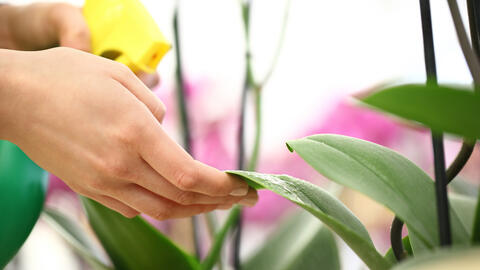Watering Orchids The correct amount is crucial
The key to good Orchid care is to water them correctly. We’ve summarized the most important rules for you.

In low humidity environments in particular, you should mist Orchids using a spray bottle
Because of their exotic origin, Orchids ask a lot of their owners. You need to be particularly careful when it comes to watering. Besides the humidity, the water you use is key. But the right watering frequency and the way you water the Orchids are also important for the plant’s health. We provide an overview of the most important watering tips.
Waterlogging often leads to a premature end for Orchids. Using a drainage layer, such as polystyrene, is particularly helpful for this. It should be at least 1.5 inches high to prevent the roots of the plant from standing in water.
If the pot feels light when lifted, the substrate is dry. This is the time to water your Orchids. Watering the plants once a week is usually sufficient. If the Orchid is in full bloom and requires a lot of energy, or it is close to a radiator, you can increase this to a maximum of two times a week. During the dormancy stage, in winter or in a cool location below 68 degrees Fahrenheit, you can water it every two weeks.
Watering your Orchids correctly is usually enough to keep them healthy and vibrant. However, if the humidity of their location is consistently below 40 percent, you should mist the plants from time to time A word of caution: Make sure that no water collects in the leaf axils or buds, as this can lead to rot. If the water you use is rich in lime, the leaves will form lime deposits. These must be removed and different water should be used.

Most Orchid experts swear that the best time to water Orchids is early in the morning. This gives the plants enough time to dry off before the cooler evening and nighttime hours.
Take your Orchid out of the planter and pour room temperature water into the plant pot only. The advantage of this method is that no water gets into those sensitive leaf axils and buds. Leave the pot to drain until hardly any water comes out. You can then return the Orchid to its planter.
Showering your Orchids allows the substrate to become evenly moist and gently removes any dust or pests. However, this method is not suitable for Orchids of the genera Paphiopedilum and Zygopetalum.
For plants without a substrate, water baths have proven to be successful. Immerse the plant for around ten minutes in a bucket of water, sink or directly in the rain barrel.

Fill a spray bottle with room temperature water and adjust to the finest setting. Mist the substrate until the water has completely permeated it and runs back out of the drainage holes at the base of the pot.
You can, of course, also use a watering can to water Orchids. Those made from plastic or ceramic and with a narrow neck are most suitable. Metal watering cans may oxidize and potentially pass on residue to the Orchids. Take some time for the plant and yourself, and moisten the substrate evenly all over. If you are using this method, you need to regularly check planters for waterlogging.
Using the right water is just as important for Orchids as finding the ideal watering balance. Only use room temperature water. A water hardness of 20 mg/L is ideal, in other words, water with a very low lime content. If the tap water in your area is too hard, you can either only have Paphiopedilum species, which are relatively lime-tolerant, or you can decalcify the tap water yourself. Leave the water overnight until the lime settles at the bottom. You can then purify it using a filter system. An easier method is to boil the water as this allows the dissolved carbon dioxide to escape, and the calcium and magnesium to be extracted. Carefully pour off the water the next morning before using it. If your water is not at the optimum pH value of five or six, it is advisable to clean the Orchids’ plastic pots once a month under running water to wash off any residue. You can find pH test strips in specialist shops. Rainwater is a healthy (and cost-effective) alternative, especially in summer.



